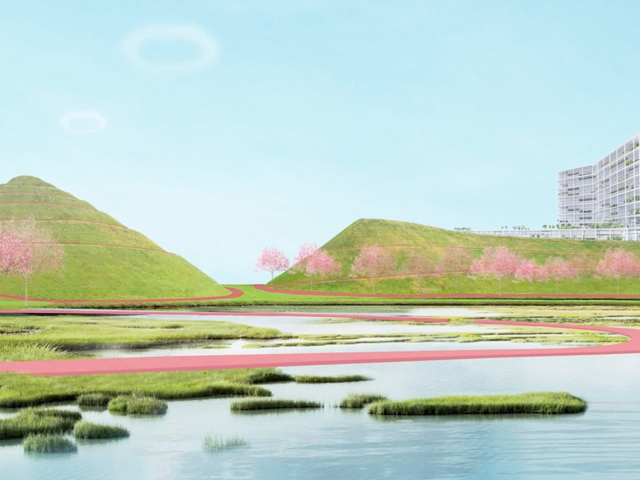HOLDING BACK THE TIDES
01 Feb 2018
Designed to protect the San Francisco Bay from flooding, BIG’s latest design concept includes a village of floating buildings connected by ferries, a cycleway and a highway for autonomous vehicles.

Developed by Danish design firm BIG in collaboration with One Architecture + Urbanism (ONE) and Sherwood Design Engineers (Sherwood) as part of Resilient by Design's Bay Area Challenge, the proposal deals with the problems in Islais Creek, an inlet of water in southern San Francisco
The Resilient by Design Challenge was started by US cities in order to develop urban designs in response to climate change, after a series of devastating and unpredictable weather events over the past few years.
One of 10 entrants selected to participate in the competition, the group's conceptual masterplan aims to improve the resilience of the area by restoring acres of natural spaces along the water's edge. This will be achieved by removing paved surfaces to allow greenery to run to the water's edge, encouraging parkland to absorb excess water and inhibit flooding. 
Design plans also include silos covered by mounds of earth to make green hills and nature pathway called the E-trail that will traverse the water’s edge and provide a safe pedestrian and cycle route for residents. With a mix of brightly coloured red and blue flooring, the path will be a vibrant addition to the scheme, together with viewing towers, trees and benches for relaxing and exploring the area.
"In light of climate change and sea level rise, can we not just save the bay, but can we grow the bay for nature, for people and for a changing climate," said BIG founder Bjarke Ingels in the team’s proposal.
The city's South Bay area is also addressed in the proposal. The team suggests that instead of building on land why not erect villages on small islands on the water, connected by a ferry service. The proposal also allows for transforming the area’s salt palms and tidal march into spaces for experimental food-production facilities, turning the rising water into an advantage for the venture. 
Tackling more than just extreme weather issues, the group’s conceptual masterplan for the Bay Area also addresses the issue regarding affordable housing, unemployment, traffic congestion and pollution.
Strategies include introducing a new bus transit loop and adapting a major route through the city to make it suitable for autonomous vehicles and public transport. High-rise warehouses with stepped garden roofs would also be built on land for offices.
In the early stages of planning, the winning schemes will receive input from local residents, city officials, and community-based organisations before being finalised. The final designs will be revealed in May 2018, ahead of the Global Climate Action Summit in San Francisco. 
"This challenge brings the best minds together, from this region and beyond, to flip the script on how we approach resilience," said Resilient by Design managing director Amanda Brown-Stevens.
"We are stepping outside traditional approaches to address climate-related vulnerabilities before we feel their biggest impact while strengthening our region's ecological and social resilience, and creating a more economically just Bay Area."







